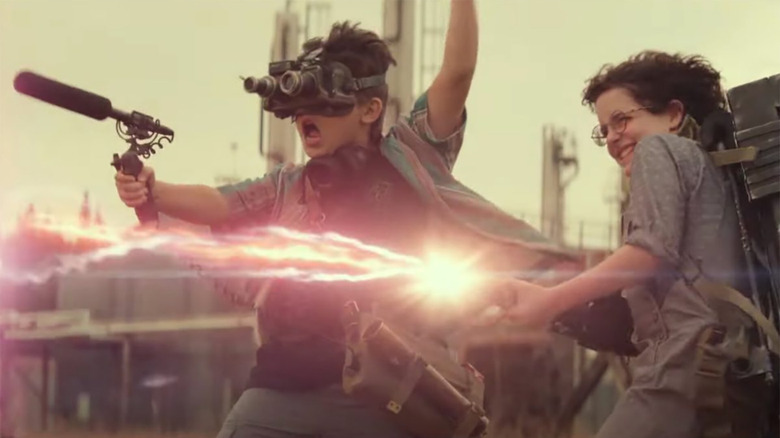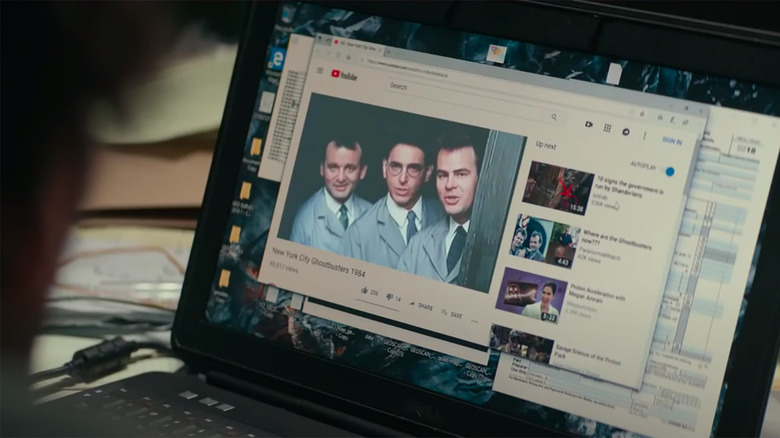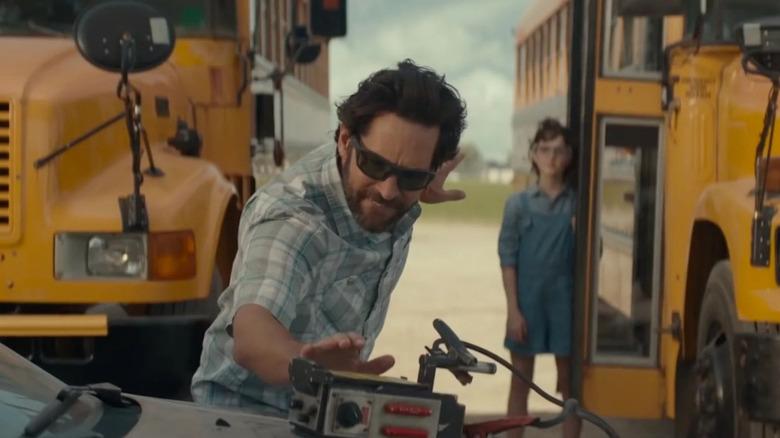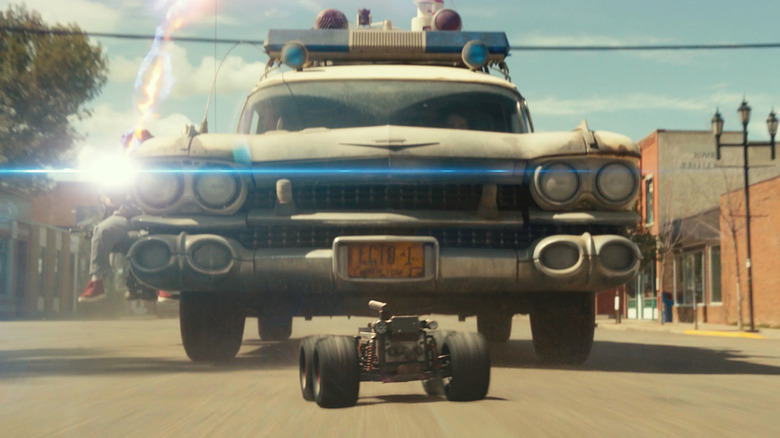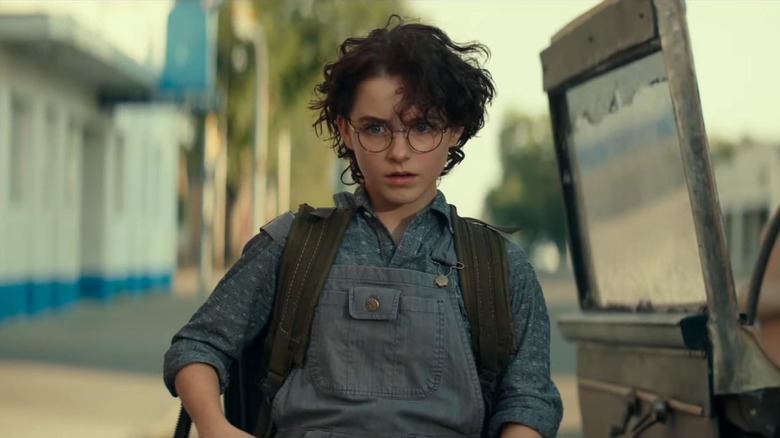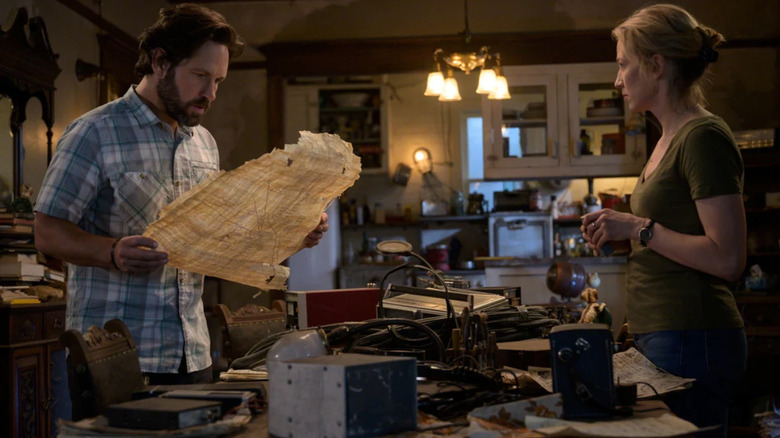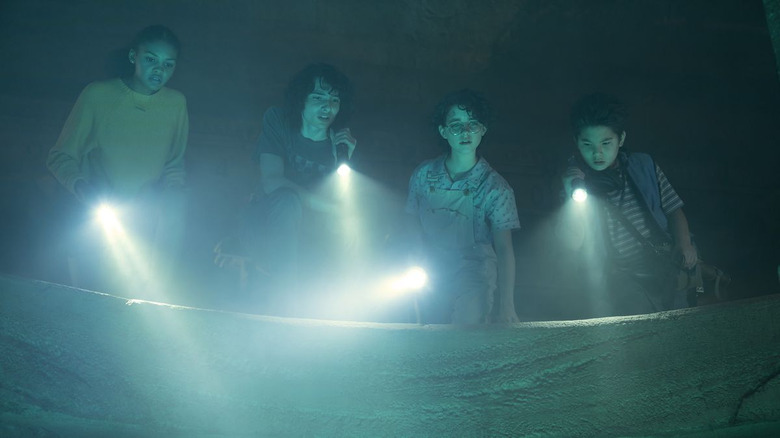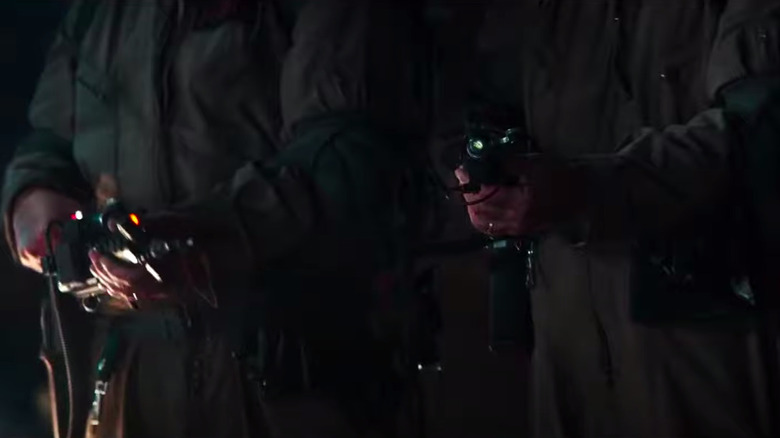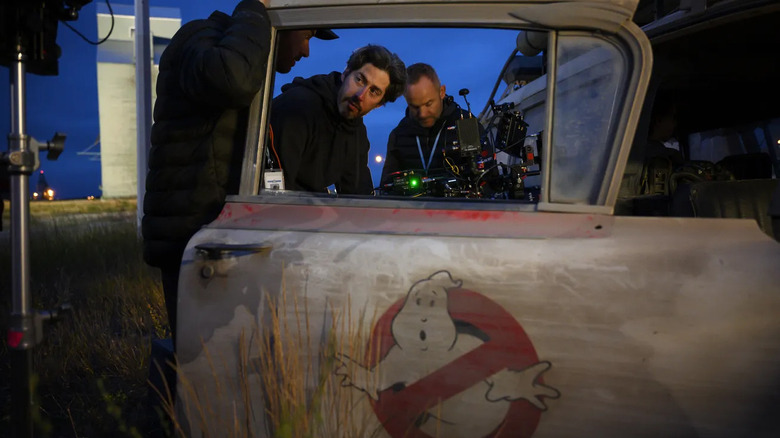Ghostbusters: Afterlife Spoiler Review: Bustin' Makes Me Feel Uneasy And Disappointed
As Hollywood continues to revive old franchises for new generations, the road most traveled is the legacy-quel that brings back all the familiar story beats, characters, and winking references to their predecessors. In the case of "Ghostbusters: Afterlife," director Jason Reitman promised "the biggest Easter egg hunt of all time" as he rounded up every possible reference to "Ghostbusters" and, to a lesser extent, "Ghostbusters II." Unfortunately, an Easter egg hunt does not a great movie make.
"Ghostbusters: Afterlife" is so chock full of nostalgia that it's basically a feature-length version of the now-meme-friendly moment in "The Avengers" where Captain America casually confirms, "I understood that reference." That's coming from the kind of "Ghostbusters" fan who has reveled in nostalgia, has been hoping for a proper "Ghostbusters" sequel for decades, and couldn't wait to see the old team in the jumpsuits and proton packs again. The problem is that the overwhelmingly inflated sense of nostalgia, reverence, and sentimentality takes the place of coherent storytelling and completely betrays the original characters, while introducing a promising set of new ones who get caught up in a messy, misguided blockbuster.
To put it another way, since we're all about Easter eggs here, in the form of a referential reworked quote from Egon Spengler in the original "Ghostbusters," I think this movie should be condemned. There's serious nostalgia fatigue in all the load-bearing moments, the storytelling is substandard, it's completely inadequate for our reboot needs, and the ending is like a demoralized zone.
Spoilers follow for "Ghostbusters: Afterlife."
Ghosts of Blockbuster Past
Let me start off by saying that I think the first two-thirds of "Ghostbusters: Afterlife" works rather well. Sardonic single mother Callie (Carrie Coon), her precocious and quirky daughter Phoebe (Mckenna Grace), and typical teen Trevor (Finn Wolfhard) have a wonderful family dynamic, and the chemistry between them makes them instantly likable and enjoyable to follow. All the pieces are there for the kind of indie gem that Jason Reitman has directed many times before. But in this case, this family plays out the exact same plot beats as the original "Ghostbusters" where the action has simply been shifted to Summerville, Oklahoma instead of New York City. And when I say the exact same plot beats, I mean it.
After the "Super 8" meets "Close Encounters of the Third Kind" opening sequence with a literally shadowy Egon Spengler provides the spooky opening that sets the stage for the sequel, Callie and her kids get evicted from their apartment, just as Peter Venkman (Bill Murray), Ray Stantz (Dan Aykroyd), and Egon (Harold Ramis) were kicked out of Columbia University. The family ends up in a dilapidated farmhouse that's pretty much just as rundown (if not moreso) as the firehouse the Ghostbusters moved into to start their spook-hunting business. With the help of the ghost of her grandfather (though she doesn't know it yet), Phoebe discovers all the Ghostbusters iconography that fans have waited to see on the big screen again for over 30 years.
First up, Phoebe discovers the ghost trap that contains whatever spirit that Egon Spengler caught before his death at familiar hands that erupted out of his living room recliner in a sequence that calls back to Sigourney Weaver's possession in "Ghostbusters." Why this moment doesn't play out in the same way with Egon being possessed and used to dismantle his own makeshift, world-saving device that will be revealed in the second act is beyond me. The simple answer is because that would upset the inciting incident that sets the entire movie in motion. However, that inciting incident and the history that comes with it isn't nearly as strong as the film would have you believe. But we'll get to that later.
Enter Paul Rudd as Gary Grooberson, the summer school teacher who's more concerned with his seismology research than educating kids.The cynicism with regards to the educational system in America, whether it's at the university or middle school level, is one of the more commendable comedic efforts in the script, mostly because there are fewer laughs here than in the original franchise. That's not to say there aren't some greatly amusing bits throughout, but there are also some painfully unfunny moments that prove this script needed a pass by a full-on comedy writer. Whenever movies like "Ghostbusters: Afterlife" are devoid of better comedy, it makes me wish someone like Patton Oswalt was on call for this kind of script doctoring all the time. Anyway, Grooberson is curious as to why Summerville is experiencing daily seismic activity without any of the traditional causes, and he's shocked and pleased to have someone like Phoebe take an interest in his work.
We're Ready to Believe You
But Mr. Grooberson actually does have something important to teach kids, and that's about the existence of the Ghostbusters. When Phoebe arrives in class with a ghost trap that she discovered in the puzzle-locked floorboards of Egon Spengler's farmhouse, the teacher immediately recognizes it as a ghost trap. But Phoebe and her new friend Podcast (Logan Kim) have no idea what he's talking about. So here's comes the education for everyone seeing "Ghostbusters: Afterlife" who somehow hasn't seen the original "Ghostbusters" yet.
First of all, it's sloppy as hell that Phoebe's supernaturally inclined friend Podcast, a character name that feels like it came from someone who mistakenly belives they understand the youths, knows nothing about the Ghostbusters, especially when you find out that videos and information about the Manhattan Crossrip of 1984 are easily available on YouTube. How is it that Gary Grooberson is one of the few people who remembers the events of the original "Ghostbusters" movie and holds them in such high esteem when details on what happened are readily available on one of the internet's most frequently visited websites? I'll concede that there's a lot of nonsense on the internet that seems unbelievable, so maybe after so many decades this stuff feels like a hoax, even though I'm not sure anyone would forget the Statue of Liberty walking down the streets of New York. But you're telling me the kid who has endlessly researched so many paranormal events for the podcast that he's dedicated to, so much that he recognizes some of the most obscure artifacts and details from mythology, has no knowledge about a 9/11-level event that happened in the biggest city in the United States? Get outta here.
Grooberson's place in the story isn't just as a nostalgia machine and educator, but he's also a plot device. The teacher's fanboy excitement gets the better of him and leads to the poor decision of juicing up the full ghost trap and unleashing one of the Terror Dogs that can lead to the return of Gozer the Gozerian. It's the first obvious hint given to the audience that we're about the see the entire plot of the original "Ghostbusters" play out in a rural setting.
Phoebe has some completely unsubtle spiritual guidance that leads to the revelation that she's the granddaughter of Egon Spengler, who is the unseen ghost who has been leading her to everything she will need in order to save the world. She's able to get her hands on a proton pack and fix one into proper working order. Following in the footsteps of the man who built the unlicensed nuclear accelerators that the Ghostbusters wear on their back, the equipment is now fully operational and ready for a literal field test where she and Podcast blast and melt glass bottles and metal beams while trying out the equipment.
We Got One!
It's off to the races with a blockbuster, action-packed sequence with the young Ghostbusters' first-ever attempt to capture and contain a ghost. In place of the hungry, green Slimer we get the equally starving Muncher. But he's totally different, bro. Because even though he's equally slimy and hungry, he's blue instead of green, has six limbs instead of two, and instead of eating whatever food he can find, he chomps on metal and can shoot little bits of it like a machine gun.
Giving the Ecto-1 a proper action sequence with Trevor recklessly in the driver's seat, Phoebe and Podcast go in hot pursuit of Muncher. Just as the original Ghostbusters destroyed the halls and banquet room of a luxury hotel, the kids wreak havoc on the small downtown area of sleepy Summerville, ripping through architecture and infrastructure with a proton stream. It's a thrilling and fun sequence, and it's one of two true showstopper scenes that lives up to the full potential of how great this movie could have been.
However, this sequence is also where some of the storytelling flaws and leaps in logic begin. Even after testing the proton stream, the kids are still quite inexperienced with all this Ghostbusters equipment. But they easily figure out how the proton pack ensnares ghosts and how to use a brand new piece of Ghostbusters technology in the form of a remote-controlled ghost trap. Trevor, who failed his driving test several times, suddenly has the driving skills of a stuntman. On top of that, he also nonchalantly mentions that he already knows about the ghost stories about Manhattan. So when Phoebe tells Trevor the Egon Spengler was their grandfather, Trevor simply understands what this means. But if he was knowledgeable enough to know the name Egon Spengler and the stories of the events of the original "Ghostbusters," why was this familial link never figured out? Why is he not floored by this information, let alone the fact that those ghost stories are real? Furthermore, how do these kids not know their mother's maiden name?
There's no time for this information to really resonate with Trevor, and it's treated as a beat that needed to be addressed logistically in order for Trevor to quickly be in on the plot and continue the fast-paced ghost chase through town. Why Muncher is the only other spirit out there besides the Terror Dogs that have been swooping through the countryside and killing Egon Spengler, we'll never know. The previous arrival of Gozer was preceded by a flurry of paranormal activity, but somehow, this new apocalyptic event doesn't come with as much pomp and circumstance. The Ghostbusters were trapping ghosts left and right leading up to the Manhattan Crossrip of 1984, but in Summerville, there's apparently nothing. There might be a good reason for that though.
Who Ya Gonna Call?
After their ghost chase ends without a successful capture of Muncher, Phoebe, Podcast, and Trevor are locked up in the town prison by the local sheriff (Bokeem Woodbine), who just so happens to be the father of Trevor's love interest Lucky (Celeste O'Connor). Lucky's place in the movie is as a love interest for Trevor and the thankless role of the fourth member of this new team of young Ghostbusters, who feels like even more of a last minute addition than Winston Zeddemore (Ernie Hudson). Her place in the rest of the movie feels like one of convenience in a key moment in the film's third act, and sadly, as charming as O'Connor is in the role, she doesn't bring nearly as much flair to the group as Winston. But that's the least of the movie's problems as we start to head towards the end of the movie.
The Ecto-1 and Ghostbusters gear is confiscated by the police. But the arrest of these young Ghostbusters also comes with some exposition. Phoebe asks for her one phone call, and she makes it to the old number for the original Ghostbusters. On the other end is Ray Stantz, still working at Ray's Occult Books from "Ghostbusters II." When Phoebe says she's calling on behalf of Egon Spengler, there's a painful and shocking moment where Ray flatly say, "Egon Spengler can rot in hell." That's a great moment, but the explanation that follows isn't worthy of such damnation.
Ray explains that after being disgraced in the wake of saving the city (twice), their work as Ghostbusters started to slow down and they were discarded by the public. So when Egon Spengler claimed that another impending, world-ending threat was at their doorstep, they weren't inclined to believe him, let alone be on board with going through all that hassle again. This prompted Egon to leave with the Ecto-1 and all their equipment to deal with the problem itself. We're not told when this happened or how long Egon has been in Summerville, but the fact that this was what led the Ghostbusters to condemn Egon Spengler is weaksauce.
After everything this team has been through, with a history that clearly goes back to before the events of the first movie, they just let Egon go like that? They were already disgraced in "Ghostbusters II" after many somehow deemed the events of the first movie as a hoax just five years later. But they still came back and saved the world again. So when another threat emerges, they're just not going to do anything about it and get mad when Egon takes the equipment that he built to finish the job they started? That goes against everything these characters stand for, and for all the forced emotion and sentimentality that comes out of the film's third act, it's not a good enough explanation for the estrangement of Egon Spengler from his friends, even though it makes sense for the distance from his family.
Speaking of which, Phoebe and Trevor, accompanied by Podcast and Lucky, go to investigate the source of all the unexplained seismic activity, which is in the mountain mines of Ivo Shandor just outside of town. Egon's way of keeping ghosts at bay is revealed to be meticulously placed proton packs set to fire at a designated time so as to keep a plethora of ghosts from being unleashed.
Gatekeeper, Keymaster, and All That Jazz
Very quickly, "Ghostbusters: Afterlife" has to get us to the point where we can recreate the ending of the original "Ghostbusters." That means we clumsily have to bring the Terror Dogs back into the equation to possess two unwilling humans to become the Keymaster and the Gatekeeper in order to allow for the return of Gozer the Gozerian. The possession of Grooberson by one is handled decently thanks to the amusing Mini-Puft scene, even if it features the eye-rolling synergistic use of both Walmart and Baskin-Robbins. It's a demented, hilarious little scene that actually feels reminiscent of the original "Ghostbusters" with a touch of "Gremlins" thrown in there. At the same time, there's no logical explanation as to why the image of the Stay Puft Marshmallow Man is appearing after it uniquely came from the mind of Ray Stantz when he inadvertently chose the form of the destructor sent to by Gozer in the first movie. But honestly, the scene is good enough to not even worry about that, at least in the moment. A lot of leaps in logic and narrative sense can be forgiven if the movie is thrilling and entertaining enough to keep you from thinking about them. But "Ghostbusters: Afterlife" just has too many of these confounding decisions to be entirely ignored.
That brings us to the spark forcibly lit between Mr. Grooberson and Callie earlier in the movie, giving us a romance of sorts that is meant to create a connection between the characters that echoes that of Dana Barrett (Sigourney Weaver) and her apartment complex neighbor Louis Tully (Rick Moranis). The film tries to recreate the quirkiness of that dynamic, but it fails horribly, especially when Callie and Grooberson meet as the Gatekeeper and Keymaster. The build-up to that moment feels contrived and awkward in a dissatisfying way and it lacks the finesse that made the original iteration of this development work so well in "Ghostbusters." I know there are a lot of comparisons to the original 1984 film popping up, but that's inevitable when you have a movie that consistently reminds you of the superior predecessor every minute.
With the Keymaster and the Gatekeeper in place, the kids are left with no choice but to break their equipment out of the police station in order to stop whatever apocalyptic even that's about to happen. Again, this is the impetus for the return of Gozer, which plays out exactly as it did in the original movie. In this case, the rooftop temple is inside of a mine, and the ghosts have been unleashed from a portal where they've been kept at bay by the conveniently placed proton packs in another part of the mine where the corpse of Gozer cult leader Ivo Shandor lies in suspended animation, awaiting the arrival of Gozer. The presence of Ivo Shandor serves no purpose, which is weird since Jason Reitman felt the need to bring in J.K. Simmons to play the character, only to be ripped in half by Gozer upon her arrival. Speaking of which, Gozer is played by Olivia Wilde, which seems fine in theory, but her appearance not being exactly like the original Gozer makes the proceedings feel like an expensive fan film. This is where "Ghostbusters: Afterlife" should have subverted expectations and had Gozer take on the form of something or someone else entirely. After all, Egon says Gozer can be whatever it wants to be, so why not use this as an opportunity to divert from the formula. It's one of the many reasons the third act starts to feel like laborious fan service without substance.
A Convoluted Battle
Where "Ghostbusters: Afterlife" does break formula is in the ending. It turns out that Egon Spengler's homestead wasn't just a rundown farmhouse. In addition to keeping Gozer and ghosts away in the mines of Summerville, he also turned his dusty, unfarmed field into a giant ghost trap comprised of dozens of individual ghost traps buried underground. There are a lot of assumptions that need to be made by our characters in order for the events of this finale to play out. Everyone seems to learn a lot very quickly about how to dispatch of Gozer. Furthermore, it's surprising that the partial body of Gozer is still threatening after the kids are able to re-trap Zuul and turn Callie back into human form. But that's more about the convenience of needing someone else to be possessed by Zuul so Callie can experience the sentimental and therapeutic moment that all the Spenglers are about to be part of.
With the focus placed squarely on Gozer, it makes the finale far smaller and less exciting than it should be. What made the original "Ghostbusters" finale so exciting was the surprise appearance of the giant Stay Puft Marshmallow Man. Since the face-off in Ivo Shandor's mine happening so quickly, it seemed like this could lead to another villain appearing. This feels like it would have been the perfect time to execute the bipedal version of the Terror Dogs that was teased earlier in the movie. But instead, it's just Gozer and the regular Terror Dogs on the farm, with Zuul now possessing Lucky. There's a little more mischief caused by the Mini-Pufts somehow reappearing, and they're all making things difficult enough for the cavalry to show up.
The timing of the old Ghostbusters showing up in their old jumpsuits and proton packs is conveniently perfect, but this is a movie, so we can easily let that slide. But how many proton packs are in play here? There were several in the mines that kept the portal of ghosts from being unleashed in the mine until the possessed Grooberson dismantled the carefully placed devices and allowed all the spooks, specters, and ghosts to be unleashed. So do Venkman, Ray, and Winston swipe them from the mines before suiting up and arriving at the farm? Something about all this feels a little off.
While these three still have a sharp dynamic when the time comes for them to help save the day again, it all feels overshadowed by what happens next.
Great Egon's Ghost!
When the original Ghostbusters arrive, they crack some jokes while reacting to the situation in typical sarcastic fashion. But it raises the question as to whether Gozer remembers the Ghostbusters. At first, she asks a familiar question to Ray, "Are you a God?" That implies she has no memory of them. If that's the case, there's no reason for the Mini-Pufts to have come forth. However, when the time comes for the team to toast this muffin, she seems to have no problem thwarting their attempt to cross the streams again. As the trio unleashes the same attack that defeated Gozer back in 1984, she simply pulls apart the streams and throws the team barreling into the Ecto-1.
Phoebe then steps up to take her place as the hero, wielding her proton stream on her own against the powerful Gozer. The electric power of the Sumerian God and this young girl's courageous proton stream meet like Volermort and Harry Potter's magic blasts in "Goblet of Fire," and there's about to be another similarity to the fantasy film's finale. As Phoebe struggles to hold Gozer back, a ghostly human hand grabs the proton pack with her. It's the physical manifestation of the ghost of Egon Spengler, an aged CGI re-creation of Harold Ramis. He grabs hold of the neutrona wand with his granddaughter, an unsettling warm smile on his digital face as he takes away the agency of this brave, young girl to be a hero on her own. This is where my heart fell into my upset stomach.
As the rest of the Ghostbusters see the spiritual form of their late friend, that's when the overt sentimentality is pushed to its breaking point. On the surface, this seems touching because Harold Ramis is no longer with us, and this also feels like the actors saying goodbye to their co-star and friend all over again. But to me, this was a ghoulish manipulation of nostalgia and love for a late actor when the very fiber of the characters he created was betrayed by the plot of this movie to set up this very moment. As each of the characters react to Egon's ghost, there are constant cuts to Egon silently smiling in bittersweet acknowledgement of their presence. It's extremely weird, because it would have been more ghoulish to give the ghost lines, even if they were from archival film footage, but this execution isn't any better either.
Egon Spengler's ghostly help combined with everyone else's efforts is enough to ensnare Gozer, and Trevor is able to activate the trap field, which not only stops Gozer, but grabs all the other swirling ghosts circling the farm. Why isn't Egon sucked into the trap with all the other ghosts? Who knows? Even more troublesome is that there's no understanding as to why Egon is the only ghost to ever appear in full human body form. Don't think about that too long or you might wonder what the deal is with all the spirits that the Ghostbusters have treated as pests to be captured. How is Egon able to manifest himself as a helpful human ghost with unfinished business when all the other ghosts we've encountered have been monstrous or zombified spooks? The hope is that you won't ask those questions because you're too busy wiping tears from your face.
After everyone has gotten a moment to lay their tear-filled eyes upon the ghost of Egon Spengler, he disappears into spiritual dust into the sky, creating the shimmer of the stars before the sweet dedication "For Harold," make the audience fawn in sweetness.
Father and Son, Filmmaking Together, Mass Hysteria!
I can't help but think that all of the more questionable aspects of this film's direction, both narratively and emotionally, would have benefitted from having a filmmaker involved outside of what we would deem "Ghostbusters" royalty. Jason Reitman grew up with all things "Ghostbusters," and Ivan Reitman is obviously far too close to the franchise. Gil Kenan co-wrote the script with Jason Reitman, but I feel like another pass from a seasoned writer outside of this core group would have improved on the film's shortcomings. The movie takes itself a little too seriously when it comes to the reverence for "Ghostbusters" as a property rather than remembering that the original movie was about a handful of guys trying to start a blue-collar paranormal extermination business with endless sarcasm and an intentionally nonchalant attitude about everything that came with it, including the end of the world. While I think the new direction of "Ghostbusters: Afterlife" is refreshing in not adhering to the same formula or comedic tone, it went too far in the other direction and that makes it feel like overwhelming fan service that tries to find emotional weight in a Nestle Crunch wrapper stuffed inside the pocket of an old jumpsuit.
What's a real shame is that there's an outstanding movie in here somewhere. The family dynamic between Callie, Phoebe, and Trevor is great, and it's the kind of stuff that Jason Reitman has done well a few times before. But he has a difficult time balancing it with the blockbuster side of the film, making for few setpieces that actually create genuine excitement and thrills. It probably didn't help that Ivan Reitman was always over his shoulder on set as a producer, offering plenty of different opinions on how the movie should be handled. Jason Reitman essentially made his version of the original "Ghostbusters," while trying to satisfy his father, the creators, and stars of the original films, and longtime fans who have been waiting for the franchise to be saved. All-in-all, it comes with a lot of emotional baggage that keeps the movie weighed down from being more than an expensive therapy session.
As a longtime "Ghostbusters" fan who counts the movie as an all-time favorite, I wanted to love this movie so much. But the ending gave me such a guttural reaction that I felt uneasy about what was attempted here. I know there will be people who find (and have already found) warmth and heart in this finale, and I'm honestly envious of them. As someone who has enjoyed plenty of nostalgia and sentiment in legacy-quels that came before, I still found all of the problems surrounding the finale, both in narrative and execution, simply too large to ignore, and it unfortunately taints the rest of the film for me.
